Here’s the Genetic Engineering and Biotechnology Student Learning Guide for this Module.
1. Overview: What is Genetic Engineering?
Genetic engineering is the process of altering the DNA in an organism’s genome. While it might be argued that humans have been genetically engineering plants and animals for thousands of years through plant and animal breeding, the kind of genetic engineering we’ll be discussing here is different: it involves direct manipulation of DNA, usually by introducing genes from one species into another.
In this tutorial, we’ll look at an example of genetic engineering that touches millions of lives each year: the synthesis of the hormone insulin to treat diabetes. Here’s a very big-picture view of how this works.
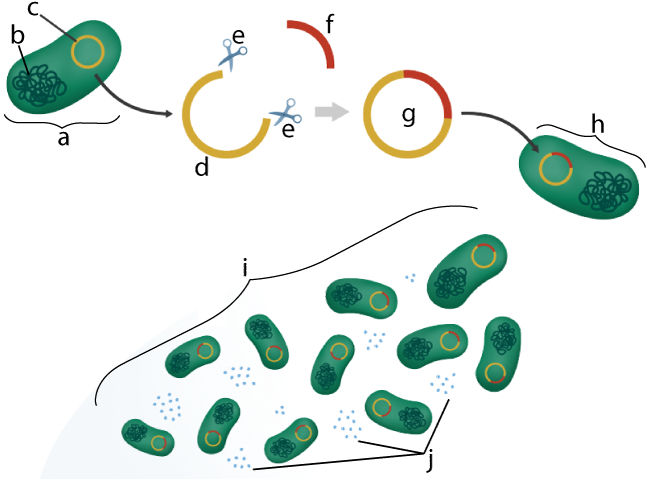
In the diagram to the right, “a” is a bacterial cell. In addition to this cell’s main chromosome (“b”) it also has a small circle of DNA that’s called a plasmid (shown at “c”). Plasmids are natural parts of the bacterial genome, and they’re often used to transfer genes between bacterial cells (a kind of horizontal exchange of genes that does not happen in animals or plants).
Using techniques of genetic engineering (some of which I’ll expand upon below), a plasmid can be extracted from a bacterial cell, and then, using enzymes (e) that act as a kind of molecular scissors, the plasmid can be cut open (as shown at “d”). This plasmid DNA can then be combined with DNA from another species (such as the human insulin gene, shown at “f”). This creates a piece of recombinant DNA (g): DNA that is combined from two sources. In this case, it’s a plasmid that contains both bacterial DNA and the human insulin gene. Then, through a technique called transformation, the genetically engineered plasmid is re-inserted into a bacterial cell (h). Every time the bacterial cell reproduces, it will copy the recombinant plasmid (i). The plasmid’s DNA will also be transcribed and translated, producing human insulin (j).
Got it? Try answering the questions that follow.
2. Checking Understanding: Genetic Engineering Overview
[qwiz random = “true” qrecord_id=”sciencemusicvideosMeister1961-Genetic Engineering, Overview, M17″] [h]
Genetic Engineering Overview
[i]
[q] In the diagram below, which letter represents the main bacterial chromosome?
[textentry single_char=”true”]
[c]IG I=[Qq]
[f]IEV4Y2VsbGVudC4gVGhlIG1haW4gYmFjdGVyaWFsIGNocm9tb3NvbWUgaXMgYXQgJiM4MjIwO2IuJiM4MjIxOw==[Qq]
[c]IEVudGVyIHdvcmQ=[Qq]
[f]IE5vLCB0aGF0JiM4MjE3O3Mgbm90IGNvcnJlY3Qu[Qq]
[c]ICo=[Qq]
[f]IE5vLiBUaGUgbWFpbiBiYWN0ZXJpYWwgY2hyb21vc29tZSBpcyB0aGUgbGFyZ2VzdCBwaWVjZSBvZiBETkEgdGhhdCB5b3UgY291bGQgZmluZCBpbiB0aGUgY2VsbC7CoA==[Qq]
[q] In the diagram below, which letter represents an unmodified plasmid?
[textentry single_char=”true”]
[c]IG M=[Qq]
[f]IE5pY2Ugam9iLsKgIFRoZSBwbGFzbWlkIGlzIGEgc21hbGwgY2lyY2xlIG9mIEROQSBpbnNpZGUgdGhlIGJhY3RlcmlhbCBjZWxsLg==[Qq]
[c]IEVudGVyIHdvcmQ=[Qq]
[f]IFNvcnJ5LCB0aGF0JiM4MjE3O3Mgbm90IGNvcnJlY3Qu[Qq]
[c]ICo=[Qq]
[f]IE5vLg==[Qq]
[q] In the diagram below, which letter represents the human insulin gene?
[textentry single_char=”true”]
[c]IG Y=[Qq]
[f]IFllcy4gQWRkZWQgRE5BIGlzIGF0ICYjODIyMDtmLiYjODIyMTs=[Qq]
[c]IEVudGVyIHdvcmQ=[Qq]
[f]IE5vLCB0aGF0JiM4MjE3O3Mgbm90IGNvcnJlY3Qu[Qq]
[c]ICo=[Qq]
[f]IE5vLCB0aGF0JiM4MjE3O3Mgbm90IGNvcnJlY3QuIEhlcmUmIzgyMTc7cyBhIGhpbnQuIEluIHRoaXMgdHlwZSBvZiBnZW5ldGljIGVuZ2luZWVyaW5nLCB0aGUgZ2VuZSBmb3IgaHVtYW4gaW5zdWxpbiBpcyBhZGRlZCB0byB0aGUgYmFjdGVyaWFsIHBsYXNtaWQuIFdoYXQmIzgyMTc7cyB0aGUgb25seSB0aGluZyB0aGF0IGNvdWxkIHJlcHJlc2VudCBhZGRlZCBETkE/[Qq]
[q] In the diagram below, a plasmid with recombinant DNA is shown at
[textentry single_char=”true”]
[c]IG c=[Qq]
[f]IE5pY2Ugam9iISBMZXR0ZXIgJiM4MjIwO2cmIzgyMjE7IHJlcHJlc2VudHMgYSByZWNvbWJpbmFudCBwbGFzbWlkLg==[Qq]
[c]IEVudGVyIHdvcmQ=[Qq]
[f]IE5vLg==[Qq]
[c]ICo=[Qq]
[f]IE5vLiBIZXJlJiM4MjE3O3MgYSBoaW50LiBJZiBEIHJlcHJlc2VudHMgdGhlIGJhY3RlcmlhbCBwbGFzbWlkLCBhbmQgRiByZXByZXNlbnRzIHRoZSBodW1hbiBpbnN1bGluIGdlbmUsIHdoYXQgaXMgdGhlIG9ubHkgbGV0dGVyIHRoYXQgY291bGQgcmVwcmVzZW50IGEgcmVjb21iaW5hbnQgcGxhc21pZD8=[Qq]
[q] In the diagram below, which letter indicates the reproduction of genetically engineered offspring?
[textentry single_char=”true”]
[c]IG k=[Qq]
[f]IFllcyEgVGhlIGxldHRlciAmIzgyMjA7aSYjODIyMTsgc2hvd3MgdGhlIG9mZnNwcmluZyBvZiB0aGUgZ2VuZXRpY2FsbHkgZW5naW5lZXJlZCBwYXJlbnQgY2VsbC4=[Qq]
[c]IEVudGVyIHdvcmQ=[Qq]
[f]IFNvcnJ5LCB0aGF0JiM4MjE3O3Mgbm90IGNvcnJlY3Qu[Qq]
[c]ICo=[Qq]
[f]Tm8uIEhlcmUmIzgyMTc7cyBhIGhpbnQuIFdoaWNoIGxldHRlciBzaG93cyB0aGUgb2Zmc3ByaW5nIG9mIHRoZSBnZW5ldGljYWxseSBlbmdpbmVlcmVkIHBhcmVudCBjZWxsPw==[Qq]
[q] In the diagram below, which letter indicates the production of genetically engineered insulin?
[textentry single_char=”true”]
[c]IG o=[Qq]
[f]IFllcyEgTGV0dGVyICYjODIyMDtqJiM4MjIxOyBpbmRpY2F0ZXMgdGhlIHByb2R1Y3Rpb24gb2YgZ2VuZXRpY2FsbHkgZW5naW5lZXJlZCBpbnN1bGluLg==[Qq]
[c]IEVudGVyIHdvcmQ=[Qq]
[f]IE5vLCB0aGF0JiM4MjE3O3Mgbm90IGNvcnJlY3Qu[Qq]
[c]ICo=[Qq]
[f]Tm8uIEhlcmUmIzgyMTc7cyBhIGhpbnQuIEluc3VsaW4gd2lsbCBiZSBzZWNyZXRlZCBmcm9tIHRoZSBnZW5ldGljYWxseSBlbmdpbmVlcmVkIGNlbGxzLCBhZnRlciB3aGljaCBpdCBjYW4gYmUgaGFydmVzdGVkIGZvciBkaXN0cmlidXRpb24uIFdoaWNoIGxldHRlciBzaG93cyBzb21ldGhpbmcgdGhhdCYjODIxNztzIGJlZW4gc2VjcmV0ZWQgZnJvbSBhIGNlbGw/[Qq]
[/qwiz]
3. The Biology of Insulin and Type 1 Diabetes
When you eat carbohydrates (foods with starch or sugar: click here for a tutorial about carbohydrates) your digestive system will convert what you’ve eaten into simple sugars (monosaccharides such as glucose). As your blood glucose level rises, your pancreas releases the hormone insulin, which binds with receptors on cells in your liver, muscles, and fatty tissues. Binding (1 below) causes intracellular signals (2) that open up glucose channels (3). The glucose diffuses into your cells, which will either convert the glucose into the polysaccharide glycogen (4) or carry out glycolysis (5), creating pyruvic acid which can then be converted into fatty acids (6).
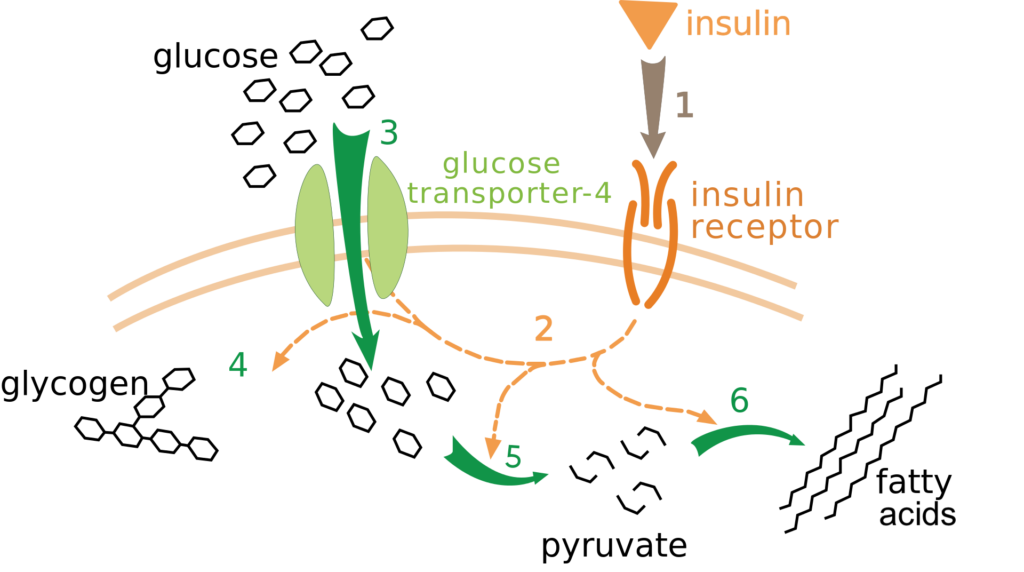
Insulin is a protein that consists of two polypeptide chains. The first chain consists of 21 amino acids, and the second consists of 30 amino acids. The two chains are connected by disulfide bridges, and there’s a third disulfide bridge that causes a hairpin turn in the larger chain (click here for a review of proteins).
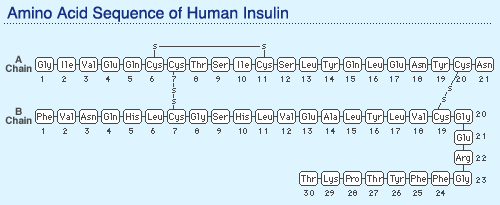
Insulin’s final shape is shown below. It’s a highly conserved protein among mammals, all of whom use it to regulate blood sugar levels. As we’ll see below, insulin from pigs and cows will bind with the human insulin receptor and induce cells to take up glucose.
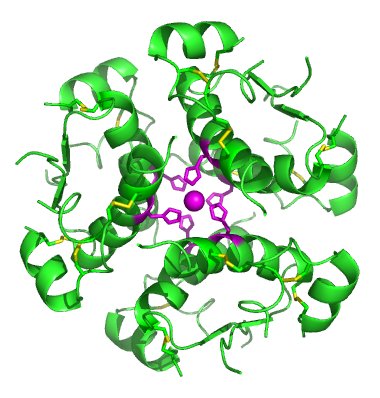
Diabetes is a disease in which people can’t regulate their blood sugar levels. There are two forms: type 1 (which generally occurs in children) and type 2 (which generally occurs in adults).
In children with type 1 diabetes, the cells in the pancreas that produce insulin are destroyed by an autoimmune reaction, and, as a result, these children can’t control their blood sugar levels. The connection between blood sugar and diabetes has been understood for centuries, but until about 1920, little could be done for children with type 1 diabetes. The only remedies were low-calorie, low-carbohydrate diets that were difficult to follow. Uncontrolled blood sugar caused widespread tissue damage, and diabetics had, with few exceptions, a limited lifespan.
The role of insulin in controlling blood sugar was discovered in the early 1900s, with a Nobel Prize awarded for this work in 1923. By the end of that year, insulin was being commercially produced and distributed, and diabetes moved from being a death sentence to being a treatable, chronic condition. (source: science history institute).
With type 1 diabetes affecting hundreds of thousands in the U.S. alone, each of whom needed multiple daily injections of insulin, the manufacture and distribution of insulin became a profitable business. This insulin was purified from animals such as cattle and pigs whose insulin was very close — but not identical — to human insulin. The differences led to problems (including allergic reactions) in some patients. In addition, there was worry about a possible shortage of pancreatic tissue from cattle and pigs to match the demand for insulin among the world’s growing population.
We’ll see below how genetic engineering was used to solve these problems. But first, take this quiz.
4. Diabetes and Insulin: Checking Understanding
[qwiz qrecord_id=”sciencemusicvideosMeister1961-Diabetes and Insulin, M17″] [h]
Insulin and Diabetes
[i]
[q] The function of insulin is to induce cells to absorb [hangman] from the bloodstream, some of which can be made into the polysaccharide [hangman]
[c]IGdsdWNvc2U=[Qq]
[f]IEdyZWF0IQ==[Qq]
[c]IGdseWNvZ2Vu[Qq]
[f]IEdyZWF0IQ==[Qq]
[q] The hormone that controls blood sugar levels is [hangman]
[c]IGluc3VsaW4=[Qq]
[f]IEdvb2Qh[Qq]
[q] [hangman] is a disease in which people are unable to control their blood sugar levels.
[c]IERpYWJldGVz[Qq]
[f]IENvcnJlY3Qh[Qq]
[q] In the diagram below, which number or letter represents glucose moving into the cells?
[textentry single_char=”true”]
[c]ID M=
[f]TmljZS4gTnVtYmVyIDMgc2hvd3MgZ2x1Y29zZSBtb3ZpbmcgaW50byBjZWxscy4=[Qq]
[c]IEVudGVyIHdvcmQ=[Qq]
[c]ICo=[Qq]
[f]IE5vLiBIZXJlJiM4MjE3O3MgYSBoaW50LiBMZXR0ZXIgJiM4MjIwO2MmIzgyMjE7IHJlcHJlc2VudHMgZ2x5Y29nZW4sIGEgcG9seW1lciBvZiBnbHVjb3NlLiBXaGljaCBudW1iZXIgY291bGQgcmVwcmVzZW50IHRoZSBtb25vbWVyIG9mIGdseWNvZ2VuIG1vdmluZyBpbnRvIHRoZSBjZWxsPw==[Qq]
[q] In the diagram below, which number or letter represents glycogen?
[textentry single_char=”true”]
[c]IG M=
[c]IFllcyEgTGV0dGVyICYjODIyMDtjJiM4MjIxOyByZXByZXNlbnRzIGdseWNvZ2VuLg==[Qq]
[c]ICo=[Qq]
[f]IE5vLiBIZXJlJiM4MjE3O3MgYSBoaW50LiBHbHljb2dlbiBpcyBhIHBvbHlzYWNjaGFyaWRlLCBtYWRlIG9mIG11bHRpcGxlIHVuaXRzIG9mIGdsdWNvc2UgYm9uZGVkIHRvZ2V0aGVyLiBJZiAmIzgyMjA7YSYjODIyMTsgaXMgZ2x1Y29zZSwgd2hhdCYjODIxNztzIHRoZSBvbmx5IHRoaW5nIG9uIHRoZSBkaWFncmFtIHRoYXQgY291bGQgcmVwcmVzZW50IGdseWNvZ2VuPw==[Qq]
[q multiple_choice=”true”] Based on the diagram below, glucose enters liver cells by
[c]IHNpbXBsZSBkaWZmdXNpb24=[Qq]
[f]IE5vLiBTaW1wbGUgZGlmZnVzaW9uIGludm9sdmVzIGRpZmZ1c2lvbiByaWdodCB0aHJvdWdoIHRoZSBtZW1icmFuZSYjODIxNztzIHBob3NwaG9saXBpZCBiaWxheWVyLiBGaW5kIGdsdWNvc2UgKGEpLiBJcyBpdCBlbnRlcmluZyB0aHJvdWdoIHRoZSBwaG9zcGhvbGlwaWQgYmlsYXllciwgb3IgaXMgaXQgdXNpbmcgYSBwcm90ZWluIGNoYW5uZWw/[Qq]
[c]IGFjdGl2ZSB0cmFuc3BvcnQ=[Qq]
[f]Tm8uIEFjdGl2ZSB0cmFuc3BvcnQgaGFwcGVucyB3aGVuIGFuIGlvbiBvciBtb2xlY3VsZSBpcyBiZWluZyBwdW1wZWQgdXAgaXRzIGNvbmNlbnRyYXRpb24gZ3JhZGllbnQsIGZyb20gbGVzc2VyIHRvIGdyZWF0ZXIgY29uY2VudHJhdGlvbi4=[Qq]
[c]IGZhY2lsaXRhdGVk IGRpZmZ1c2lvbi4=[Qq]
[f]RXhjZWxsZW50LiBHbHVjb3NlIGlzIGRpZmZ1c2lvbiBhY3Jvc3MgdGhlIG1lbWJyYW5lIHRocm91Z2ggYSBwcm90ZWluIGNoYW5uZWwsIGEgcHJvY2VzcyBrbm93biBhcyBmYWNpbGl0YXRlZCBkaWZmdXNpb24u[Qq]
[/qwiz]
5. Genetically Engineered Insulin
5a. Making Recombinant DNA
The techniques of genetic engineering were first developed in the early 1970s. The first breakthrough came about when Paul Berg, working at Stanford University, created the first recombinant DNA molecules. Recombinant DNA is DNA that is combined from multiple sources.
To make recombinant DNA, you have to be able to cut apart DNA from at least two different sources and combine them. In the big-picture view of genetic engineering above, I referred to enzymes that act as “molecular scissors.” These enzymes are called restriction endonucleases, or restriction enzymes. These enzymes evolved in bacteria as a defense against viral attacks, and they work by cleaving viral DNA. This keeps viruses from taking over the bacterial cells into which they’ve injected their DNA. In other words, these enzymes restricted the ability of bacterial viruses to take over bacterial cells: hence, “restriction enzymes.”
Restriction enzymes can recognize specific short sequences of viral DNA (as short as six nucleotides) and cut the DNA at a point within that sequence.
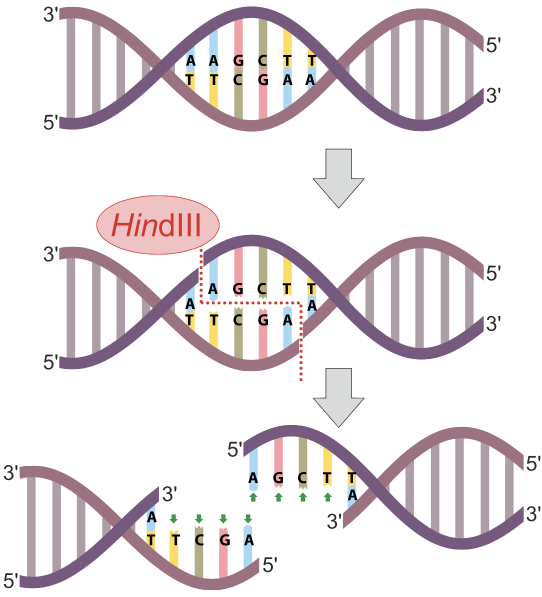
In the example at left, the restriction endonuclease HindIII recognizes the nucleotide sequence AAGCTT and cuts the DNA between the two As. Note that because the sequence is a palindrome (it’s the same in the 5′ to 3′ direction on both strands), the cut winds up being double-stranded, and completely severs the DNA.
Since the time of their initial discovery, over 4000 restriction enzymes have been identified. If you want to learn more about them, follow this link, which will open in a new tab.
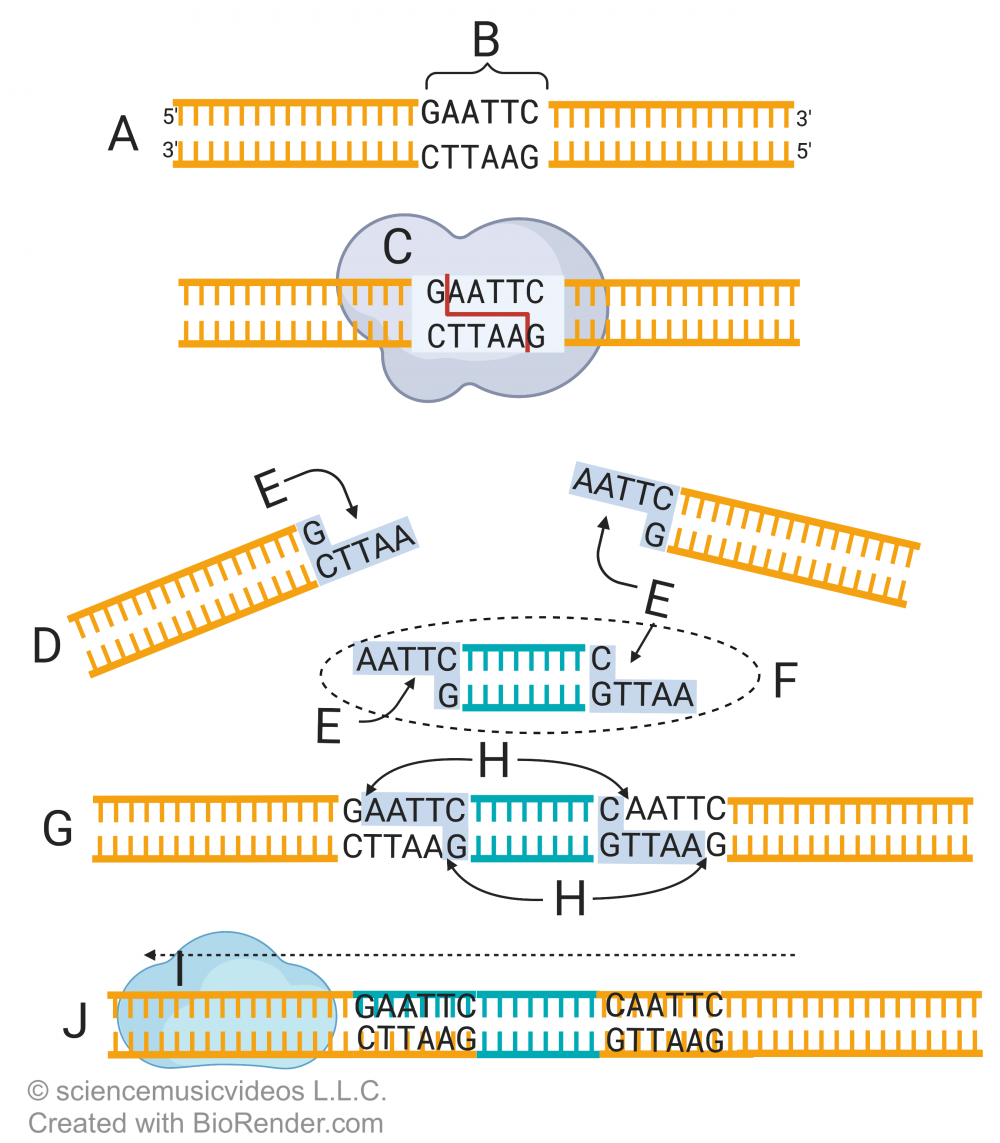
Here’s how restriction enzymes are used to create recombinant DNA. Letter A shows a stretch of DNA, within which is the sequence GAATTC. That sequence is a restriction site (B). It’s recognized by a restriction enzyme (C), which acts as a type of molecular scissors, cutting the sugar-phosphate bonds in the DNA between the nucleotide bases guanine and adenine (just look for the arrow between the G and A in the DNA).
The result is two DNA fragments (D), each with a “sticky end ” (E). The ends are sticky because they contain exposed nucleotide bases that are ready to form hydrogen bonds with complementary nucleotides.
Letter “F” represents a second stretch of DNA from another species or organism that’s been cut with the same restriction enzyme. If that piece of DNA (F) is mixed with the DNA fragments at “D,” then the two can combine as is shown in “G.” At this point, the DNA is held together just by the hydrogen bonds between the sticky ends of each fragment. “H” represents a gap: a missing sugar-phosphate bond that would connect the fragments into a single strand.
The last step involves a second enzyme, DNA ligase (i). DNA ligase creates sugar-phosphate bonds between adjacent nucleotides. Once ligase has done its work, you have recombinant DNA (J): DNA molecule with sequences from different species.
5b. Getting the DNA for Human Insulin
In that same year, Herbert Boyer and Stanley Cohen introduced a recombinant plasmid into a bacterial cell: they took a gene for resistance to kanamycin (an antibiotic) and inserted it into a plasmid. When they then inserted this modified plasmid into bacterial cells, the resulting bacteria were kanamycin resistant. In 1973, they introduced a gene from a toad into bacteria, proving that genes could be moved from animals into bacteria.
Once these techniques were developed, scientists and investors began to think about how they could profit from this technology. The huge market for insulin made the genetic engineering of human insulin an early target of those efforts, and that target was pursued by two nascent biotechnology firms in the early 1980s: Biogen and Genentech. The goal became the successful insertion of the genes for human insulin into a bacterial plasmid. But how was that human DNA to be acquired? Two techniques were used.
The first, pursued by a biotech company called Genentech, involved creating an artificial copy of the insulin gene. Knowing the primary structure of the human insulin protein (see above) scientists could work backward to construct DNA that would code for that protein.
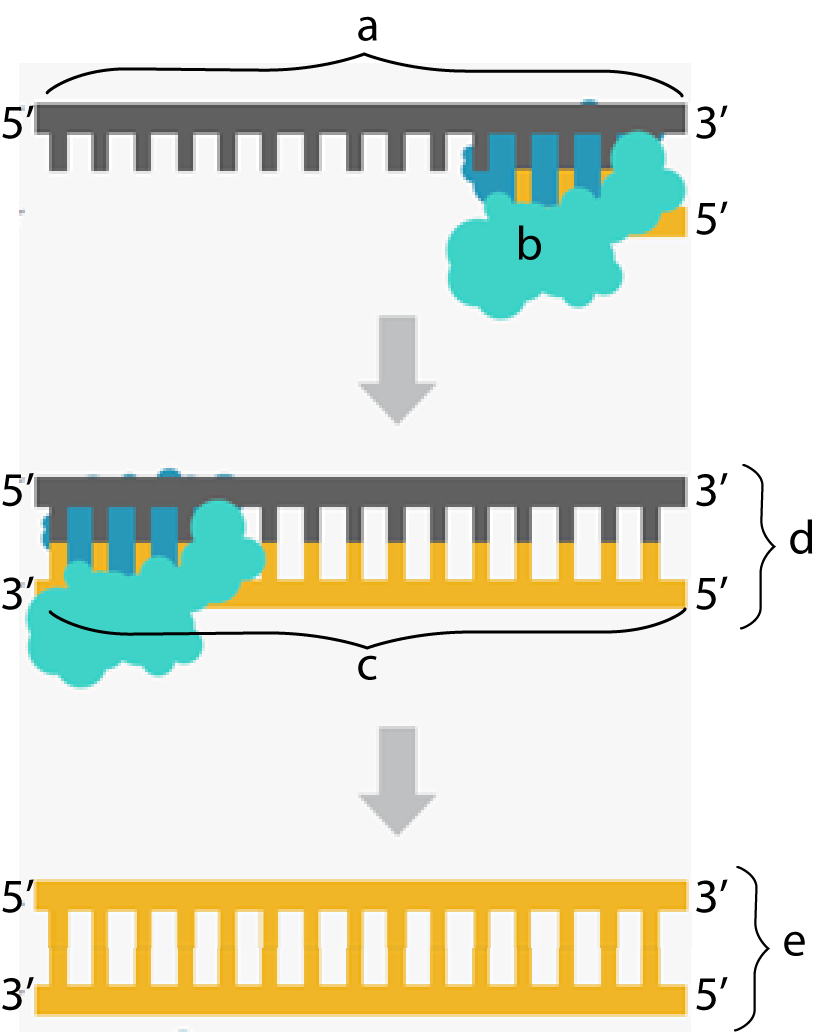
The second way the insulin gene was isolated was used by the biotech company Biogen. Biogen deployed a biochemical trick that evolved in a class of viruses called retroviruses (such as HIV). Retroviruses store their genetic information in the nucleic acid RNA and then use an enzyme called reverse transcriptase to convert their RNA into DNA. Taking a page from this viral playbook, Biogen did the following:
- Cells that produced insulin were isolated from pancreatic tissue and grown in tissue culture.
- The messenger RNA from these cells was isolated, and then reverse transcriptase was used to create DNA that complemented the insulin-coding RNA. In the diagram above and to the right, “a” is mRNA, and “b” is reverse transcriptase.
- As reverse transcriptase moves along the RNA, it lays down new deoxyribonucleotides, synthesizing a new strand in the 5′ to 3′ direction. This creates a strand that’s half RNA and half DNA (shown at “d”).
- Subsequent manipulation with additional enzymes removes the RNA, replacing it with DNA. The result is shown at “e.”
DNA made this way is called cDNA, for complementary DNA. Unlike DNA that would be spliced out of a eukaryotic chromosome, it has the advantage of being intron-free, and only contains the exons for the insulin protein.
Either DNA would have worked. Genentech wound up being the winner. Genentech sold the licensing rights to genetically engineered insulin to Eli Lilly, the U.S.’s biggest producer of insulin.
6. Genetic Engineering and Recombinant DNA: Interactive Diagrams
[qwiz qrecord_id=”sciencemusicvideosMeister1961-Genetic Engineering and Recombinant DNA, Interactive Diagrams, M17″]
[h]Genetic Engineering and Recombinant DNA
[i]
[q labels = “top”]
[l]human DNA
[fx] No, that’s not correct. Please try again.
[f*] Great!
[l]unmodified plasmid
[fx] No. Please try again.
[f*] Great!
[l]recombinant DNA
[fx] No, that’s not correct. Please try again.
[f*] Correct!
[l]genetically modified bacterium
[fx] No, that’s not correct. Please try again.
[f*] Correct!
[q labels = “top”]
[l]Ligase
[fx] No. Please try again.
[f*] Good!
[l]recombinant DNA
[fx] No, that’s not correct. Please try again.
[f*] Great!
[l]restriction enzyme
[fx] No, that’s not correct. Please try again.
[f*] Excellent!
[l]sticky ends
[fx] No. Please try again.
[f*] Excellent!
[q labels = “top”]
[l]complementary DNA
[fx] No, that’s not correct. Please try again.
[f*] Good!
[l]hybrid RNA/DNA
[fx] No, that’s not correct. Please try again.
[f*] Great!
[l]reverse transcriptase
[fx] No. Please try again.
[f*] Good!
[/qwiz]
7. The Genie’s out of the Bottle
Watson and Crick described the structure of DNA in 1953. By 1973, DNA was being engineered to suit human ends. Now, using techniques very similar to those used to develop genetically engineered insulin, recombinant DNA is everywhere. It’s being deployed to create drugs to treat many diseases, including AIDS, a variety of cancers, cystic fibrosis, hemophilia, genital warts, hepatitis, and human growth hormone deficiency.
The 1980s also saw the development of the first transgenic animals: animals whose genomes were altered through the insertion of genes from other species. These include
- mice with human genes (widely used for research purposes),
- transgenic goats which produce milk that contains substances that prevent the formation of harmful blood clots during surgery (the drugs are extracted from the milk);
- pigs modified with the goal that their organs can be transplanted into humans;
Transgenic crops (also referred to as genetically modified crops or GMOs) have been widely in use since the 1990s. It’s estimated that in 2016, 10% of the world’s cropland was planted with genetically modified plants. (Wikipedia). These include crops such as soybeans, maize (corn), and cotton, which have been modified for increased resistance to pests, and reduction of spoilage.
Transgenic crops can also have improved nutrient profiles. An example of the latter is Golden Rice (Wikipedia): rice that’s been genetically modified to produce beta carotene. Beta carotene is a precursor to vitamin A. Vitamin A deficiency causes hundreds of thousands of childhood deaths in regions where people consume inadequate amounts of that vitamin in their diets. In late 2019, the government of the Philippines approved Golden Rice for human consumption, making it the first Asian country to approve Golden Rice for direct use.
8. Checking Understanding: Genetically Engineered Insulin
The following quiz will help you master everything you’ve read above.
[qwiz random = “true” qrecord_id=”sciencemusicvideosMeister1961-Genetic Engineering of Insulin, M17″] [h]
Genetic Engineering Quiz
[i]
[q] In the diagram below, a eukaryotic gene of interest is indicated by
[textentry single_char=”true”]
[c]ID E=[Qq]
[f]IFllcy4gMSBpcyB0aGUgZ2VuZSBvZiBpbnRlcmVzdC4=[Qq]
[c]IEVudGVyIHdvcmQ=[Qq]
[f]IFNvcnJ5LCB0aGF0JiM4MjE3O3Mgbm90IGNvcnJlY3Qu[Qq]
[c]ICo=[Qq]
[f]Tm8uIEhlcmUmIzgyMTc7cyBhIGhpbnQuIFRoZSBETkEgaXMgZ29pbmcgdG8gYmUgY3V0IHdpdGggYSByZXN0cmljdGlvbiBlbnp5bWUgdG8gaXNvbGF0ZSB0aGUgZ2VuZS4gSWYgcmVzdHJpY3Rpb24gZW56eW1lcyBhcmUgYXQgJiM4MjIwOzIsJiM4MjIxOyB0aGVuIHdoaWNoIG51bWJlciBoYXMgdG8gYmUgdGhlIGV1a2FyeW90aWMgZ2VuZSBvZiBpbnRlcmVzdD8=[Qq]
[q] In the diagram below, restriction enzymes are at which number?
[textentry single_char=”true”]
[c]ID I=[Qq]
[f]TmljZSBqb2IhIFJlc3RyaWN0aW9uIGVuenltZXMgYXJlIHJlcHJlc2VudGVkIGJ5IDIu[Qq]
[c]ZW50ZXIgd29yZA==[Qq]
[f]IE5vLg==[Qq]
[c]ICo=[Qq]
[f]Tm8uIFJlc3RyaWN0aW9uIGVuenltZXMgYXJlIHVzZWQgdG8gY3V0IEROQS4gV2hhdCYjODIxNztzIHRoZSBvbmx5IHRoaW5nIGluIHRoaXMgZGlhZ3JhbSB0aGF0IGNvdWxkIGluZGljYXRlIHNvbWV0aGluZyB0aGF0IGN1dHMgc29tZXRoaW5nIGVsc2Ugb3Blbj8=[Qq]
[q] In the diagram below, a non-recombinant plasmid is indicated by
[textentry single_char=”true”]
[c]ID M=[Qq]
[f]V2F5IHRvIGdvLiBUaGUgdW5tb2RpZmllZCBwbGFzbWlkIGlzIGluZGljYXRlZCBieSAmIzgyMjA7My4mIzgyMjE7[Qq]
[c]ZW50ZXIgd29yZA==[Qq]
[f]IE5vLg==[Qq]
[c]ICo=[Qq]
[f]Tm8uIEhlcmUmIzgyMTc7cyBhIGhpbnQ6IGEgcGxhc21pZCBpcyBhIGNpcmNsZSBvZiBleHRyYS1jaHJvbW9zb21hbCBiYWN0ZXJpYWwgRE5BLiBGaW5kIHRoZSBjaXJjbGUmIzgyMzA7[Qq]
[q] In the diagram below, DNA ligase is indicated by
[textentry single_char=”true”]
[c]ID Q=[Qq]
[f]IFllcyEgTGlnYXNlIGlzIGF0IG51bWJlciA0Lg==[Qq]
[c]IEVudGVyIHdvcmQ=[Qq]
[f]IE5vLg==[Qq]
[c]ICo=[Qq]
[f]IE5vLiBMaWdhc2UmIzgyMTc7cyBmdW5jdGlvbiBpcyB0byBjcmVhdGUgc3VnYXItcGhvc3BoYXRlIGJvbmRzIGJldHdlZW4gRE5BIGZyYWdtZW50cy4gV2hhdCYjODIxNztzIG9uIHRoaXMgZGlhZ3JhbSB0aGF0IGNvdWxkIHJlcHJlc2VudCB0aGF0P8Kg[Qq]
[q] In the diagram below, fragments of DNA with “sticky ends” are represented by
[textentry single_char=”true”]
[c]ID U=[Qq]
[f]IEF3ZXNvbWUhIFRoZSBzdGlja3kgZW5kcyBhcmUgcmVwcmVzZW50ZWQgYnkgJiM4MjIwOzUuJiM4MjIxOw==[Qq]
[c]IEVudGVyIHdvcmQ=[Qq]
[f]IE5vLg==[Qq]
[c]ICo=[Qq]
[f]IE5vLiBIZXJlJiM4MjE3O3MgYSBoaW50OiBTdGlja3kgZW5kcyBhcmUgZXhwb3NlZCBiYXNlcyB0aGF0IHdpbGwgZm9ybSBoeWRyb2dlbiBib25kcyB3aXRoIG9uZSBhbm90aGVyLiBXaGVuIHRoZSBzYW1lIHJlc3RyaWN0aW9uIGVuenltZSBpcyB1c2VkIHRvIGN1dCBETkEsIHRoZSByZXN1bHRzIHdpbGwgYmUgZnJhZ21lbnRzIHdpdGggdGhlc2Ugc3RpY2t5IGVuZHMu[Qq]
[q] In the diagram below, a recombinant plasmid is shown at
[textentry single_char=”true”]
[c]ID Y=[Qq]
[f]IEV4Y2VsbGVudC4gVGhlIHJlY29tYmluYW50IHBsYXNtaWQgaXMgYXQgJiM4MjIwOzYuJiM4MjIxOw==[Qq]
[c]IEVudGVyIHdvcmQ=[Qq]
[f]IE5vLg==[Qq]
[c]ICo=[Qq]
[f]IE5vLiBIZXJlJiM4MjE3O3MgYSBoaW50OiBUaGUgcmVjb21iaW5hbnQgcGxhc21pZCB3aWxsIGNvbnNpc3Qgb2YgYSBodW1hbiBnZW5lICgxKSwgYW5kIHRoZSBvcmlnaW5hbCBwbGFzbWlkLg==[Qq]
[q] Organisms that have been modified to contain DNA from more than one species are called[hangman]. Often, these organisms are referred to as genetically [hangman] organisms, or GMOs.
[c]IHRyYW5zZ2VuaWM=[Qq]
[f]IEdvb2Qh[Qq]
[c]IG1vZGlmaWVk[Qq]
[f]IEV4Y2VsbGVudCE=[Qq]
[q] Enzymes used to cut DNA are called[hangman] enzymes.
[c]IHJlc3RyaWN0aW9u[Qq]
[f]IEdyZWF0IQ==[Qq]
[q] DNA [hangman]is the enzyme that connects DNA fragments by creating sugar-phosphate bonds.
[c]IGxpZ2FzZQ==[Qq]
[f]IEdyZWF0IQ==[Qq]
[q] [hangman] DNA is DNA that has been pieced together from multiple sources.
[c]IFJlY29tYmluYW50[Qq]
[f]IENvcnJlY3Qh[Qq]
[q] In the diagram below, a restriction site is shown at letter
[textentry single_char=”true”]
[c]IE I=[Qq]
[f]IEdyZWF0ISAmIzgyMjA7QiYjODIyMTsgc2hvd3MgYSByZXN0cmljdGlvbiBzaXRlLsKg[Qq]
[c]IEVudGVyIHdvcmQ=[Qq]
[f]IFNvcnJ5LCB0aGF0JiM4MjE3O3Mgbm90IGNvcnJlY3Qu[Qq]
[c]ICo=[Qq]
[f]IE5vLiBUaGUgcmVzdHJpY3Rpb24gc2l0ZSBpcyB3aGVyZSB0aGUgcmVzdHJpY3Rpb24gZW56eW1lcyB3aWxsIGN1dCBhcGFydCB0aGUgRE5BLg==[Qq]
[q] In the diagram below, a restriction enzyme is shown at
[textentry single_char=”true”]
[c]IG M=[Qq]
[f]IEV4Y2VsbGVudCEgJiM4MjIwO0MmIzgyMjE7IHNob3dzIGEgcmVzdHJpY3Rpb24gZW56eW1lLsKg[Qq]
[c]IEVudGVyIHdvcmQ=[Qq]
[f]IE5vLg==[Qq]
[c]ICo=[Qq]
[f]IE5vLiBUaGUgcmVzdHJpY3Rpb24gZW56eW1lIGlzIHdoYXQgY3V0cyB0aGUgRE5BIGludG8gZnJhZ21lbnRzLg==[Qq]
[q] In the diagram below, “sticky ends” are shown at
[textentry single_char=”true”]
[c]IE U=[Qq]
[f]IENvcnJlY3QhIFN0aWNreSBlbmRzIGFyZSBzaG93biBhdCAmIzgyMjA7RS4mIzgyMjE7[Qq]
[c]IEVudGVyIHdvcmQ=[Qq]
[f]IE5vLCB0aGF0JiM4MjE3O3Mgbm90IGNvcnJlY3Qu[Qq]
[c]ICo=[Qq]
[f]IE5vLiBIZXJlJiM4MjE3O3MgYSBoaW50LiBUaGUgJiM4MjIwO3N0aWNreSBlbmRzJiM4MjIxOyBhcmUgZXhwb3NlZCBiYXNlcywgcmVhZHkgdG8gZm9ybSBoeWRyb2dlbiBib25kcyB3aXRoIGZyYWdtZW50cyB0aGF0IGhhdmUgY29tcGxlbWVudGFyeSBzZXF1ZW5jZXMu[Qq]
[q] In the diagram below, gaps that need to be sealed together by DNA ligase are shown at
[textentry single_char=”true”]
[c]IE g=[Qq]
[f]IENvcnJlY3QhICYjODIyMDtIJiM4MjIxOyByZXByZXNlbnRzIHRoZSBnYXBzIChhIHN1Z2FyLXBob3NwaGF0ZSBib25kIHRoYXQgbmVlZHMgdG8gYmUgY2F0YWx5emVkKS7CoA==[Qq]
[c]IEVudGVyIHdvcmQ=[Qq]
[f]IE5vLCB0aGF0JiM4MjE3O3Mgbm90IGNvcnJlY3Qu[Qq]
[c]ICo=[Qq]
[f]IE5vLiBIZXJlJiM4MjE3O3MgYSBoaW50LiBUaGUgZ2FwcyBhcmUgd2hhdCBnZXQgc2VhbGVkIGJ5IEROQSBsaWdhc2UgKHNob3duIGF0ICYjODIyMDtJJiM4MjIxOyku[Qq]
[q] In the diagram below, DNA ligase is shown at
[textentry single_char=”true”]
[c]IE k=[Qq]
[f]IENvcnJlY3QhICYjODIyMDtJJiM4MjIxOyByZXByZXNlbnRzIGxpZ2FzZS7CoA==[Qq]
[c]IEVudGVyIHdvcmQ=[Qq]
[f]IE5vLCB0aGF0JiM4MjE3O3Mgbm90IGNvcnJlY3Qu[Qq]
[c]ICo=[Qq]
[f]IE5vLiBIZXJlJiM4MjE3O3MgYSBoaW50LiBMaWdhc2Ugc2VhbHMgdGhlIGdhcHMgdGhhdCBhcmUgc2hvd24gYXQgJiM4MjIwO0guJiM4MjIxOw==[Qq]
[q] In the diagram below, completed recombinant DNA is shown at
[textentry single_char=”true”]
[c]IE o=[Qq]
[f]IENvcnJlY3QhICYjODIyMDtKJiM4MjIxOyBpcyB0aGUgZmluaXNoZWQgcmVjb21iaW5hbnQgRE5BLg==[Qq]
[c]IEVudGVyIHdvcmQ=[Qq]
[f]IE5vLCB0aGF0JiM4MjE3O3Mgbm90IGNvcnJlY3Qu[Qq]
[c]ICo=[Qq]
[f]IE5vLiBIZXJlJiM4MjE3O3MgYSBoaW50LiBSZWNvbWJpbmFudCBETkEgY29tYmluZXMgdGhlIGZyYWdtZW50cyBhdCAmIzgyMjA7RCYjODIyMTsgYW5kICYjODIyMDtGLiYjODIyMTs=[Qq]
[q] DNA made from RNA using reverse transcriptase is known as [hangman] DNA.
[c]IGNvbXBsZW1lbnRhcnk=[Qq]
[f]IEdyZWF0IQ==[Qq]
[q multiple_choice=”true”] The enzyme responsible for creating sugar-phosphate bonds between DNA fragments is/are
[c]IEROQSBwb2x5bWVyYXNl[Qq]
[f]IE5vLiBETkEgcG9seW1lcmFzZSBpcyBhIGtleSBlbnp5bWUgcmVzcG9uc2libGUgZm9yIHN5bnRoZXNpemluZyBuZXcgRE5BLiBIZXJlJiM4MjE3O3MgYSBoaW50OiBjcmVhdGluZyB0aGVzZSBzdWdhci1waG9zcGhhdGUgYm9uZHMgaXMgY2FsbGVkICYjODIyMDtsaWdhdGlvbi4mIzgyMjE7[Qq]
[c]IFJldmVyc2UgdHJhbnNjcmlwdGFzZQ==[Qq]
[f]IE5vLiBSZXZlcnNlIHRyYW5zY3JpcHRhc2UgdGFrZXMgUk5BIGFuZCByZXZlcnNlIHRyYW5zY3JpYmVzIGl0IGludG8gRE5BLiBIZXJlJiM4MjE3O3MgYSBoaW50OiBjcmVhdGluZyB0aGVzZSBzdWdhci1waG9zcGhhdGUgYm9uZHMgaXMgY2FsbGVkICYjODIyMDtsaWdhdGlvbi4mIzgyMjE7[Qq]
[c]IFJlc3RyaWN0aW9uIGVuenltZXM=[Qq]
[f]IE5vLiBSZXN0cmljdGlvbiBlbnp5bWVzIGFyZSByZXNwb25zaWJsZSBmb3IgY3V0dGluZyBETkEgaW50byBmcmFnbWVudHMuIEhlcmUmIzgyMTc7cyBhIGhpbnQ6IGNyZWF0aW5nIHRoZXNlIHN1Z2FyLXBob3NwaGF0ZSBib25kcyBpcyBjYWxsZWQgJiM4MjIwO2xpZ2F0aW9uLiYjODIyMTs=[Qq]
[c]IEROQSBs aWdhc2U=[Qq]
[f]IENvcnJlY3QhIEROQSBMaWdhc2UgY3JlYXRlcyBzdWdhci1waG9zcGhhdGUgYm9uZHMgYmV0d2VlbiBhZGphY2VudCBmcmFnbWVudHMgb2YgRE5BLg==[Qq]
[q multiple_choice=”true”] The enzyme that can synthesize DNA from an RNA template is
[c]IEROQSBwb2x5bWVyYXNl[Qq]
[f]IE5vLiBETkEgcG9seW1lcmFzZSBpcyBhIGtleSBlbnp5bWUgcmVzcG9uc2libGUgZm9yIHN5bnRoZXNpemluZyBuZXcgRE5BLg==[Qq]
[c]IFJldmVyc2UgdHJh bnNjcmlwdGFzZQ==[Qq]
[f]IE5pY2Ugam9iLiBSZXZlcnNlIHRyYW5zY3JpcHRhc2UgdGFrZXMgUk5BIGFuZCByZXZlcnNlIHRyYW5zY3JpYmVzIGl0IGludG8gRE5BLg==[Qq]
[c]IFJlc3RyaWN0aW9uIGVuenltZXM=[Qq]
[f]IE5vLiBSZXN0cmljdGlvbiBlbnp5bWVzIGFyZSByZXNwb25zaWJsZSBmb3IgY3V0dGluZyBETkEgaW50byBmcmFnbWVudHM=[Qq]
[c]IEROQSBsaWdhc2U=[Qq]
[f]IE5vLiBETkEgTGlnYXNlIGNyZWF0ZXMgc3VnYXItcGhvc3BoYXRlIGJvbmRzIGJldHdlZW4gYWRqYWNlbnQgZnJhZ21lbnRzIG9mIEROQS4=[Qq]
[q multiple_choice=”true”] The enzyme that can cut DNA into fragments is
[c]IEROQSBwb2x5bWVyYXNl[Qq]
[f]IE5vLiBETkEgcG9seW1lcmFzZSBpcyBhIGtleSBlbnp5bWUgcmVzcG9uc2libGUgZm9yIHN5bnRoZXNpemluZyBuZXcgRE5BLg==[Qq]
[c]IFJldmVyc2UgdHJhbnNjcmlwdGFzZQ==[Qq]
[f]IE5vLiBSZXZlcnNlIHRyYW5zY3JpcHRhc2UgdGFrZXMgUk5BIGFuZCByZXZlcnNlIHRyYW5zY3JpYmVzIGl0IGludG8gRE5BLg==[Qq]
[c]IFJlc3RyaWN0aW 9uIGVuenltZXM=[Qq]
[f]IEV4Y2VsbGVudC4gUmVzdHJpY3Rpb24gZW56eW1lcyBhcmUgcmVzcG9uc2libGUgZm9yIGN1dHRpbmcgRE5BIGludG8gZnJhZ21lbnRz[Qq]
[c]IEROQSBsaWdhc2U=[Qq]
[f]IE5vLiBETkEgTGlnYXNlIGNyZWF0ZXMgc3VnYXItcGhvc3BoYXRlIGJvbmRzIGJldHdlZW4gYWRqYWNlbnQgZnJhZ21lbnRzIG9mIEROQS4=[Qq]
[q] In the diagram below, a restriction enzyme is represented by
[textentry single_char=”true”]
[c]IG U=[Qq]
[f]IENvcnJlY3QhIExldHRlciAmIzgyMjA7ZSYjODIyMTsgaXMgYSByZXN0cmljdGlvbiBlbnp5bWUu[Qq]
[c]IEVudGVyIHdvcmQ=[Qq]
[f]IE5vLg==[Qq]
[c]ICo=[Qq]
[f]IE5vLiBIZXJlJiM4MjE3O3MgYSBoaW50LiBSZXN0cmljdGlvbiBlbnp5bWVzIGN1dCBvcGVuIEROQS4=[Qq]
[q] In the diagram below, HindIII must be a(n) [hangman] enzyme.
[c]IHJlc3RyaWN0aW9u[Qq]
[f]IEV4Y2VsbGVudCE=[Qq]
[q] In the diagram below, the DNA bases with green arrows represent[hangman] ends.
[c]IHN0aWNreQ==[Qq]
[f]IEV4Y2VsbGVudCE=[Qq]
[q] In the diagram below, a plasmid that’s been treated with a restriction enzyme is shown at
[textentry single_char=”true”]
[c]IG U=[Qq]
[c]WWVzISBMZXR0ZXIgJiM4MjIwO2UmIzgyMjE7IHNob3dzIGEgcGxhc21pZCB0aGF0JiM4MjE3O3MgYmVlbiBjdXQgb3BlbiBieSBhIHJlc3RyaWN0aW9uIGVuenltZS4=[Qq]
[c]ICo=[Qq]
[f]IE5vLiBIZXJlJiM4MjE3O3MgYSBoaW50LiBBIHBsYXNtaWQgdGhhdCA=aGFzbiYjODIxNzt0IGJlZW4gdHJlYXRlZCB3aXRoIGEgcmVzdHJpY3Rpb24gZW56eW1lIGlzIHNob3duIGF0ICYjODIyMDthLiYjODIyMTs=[Qq]
[q] In the diagram below, recombinant DNA first appears at
[textentry single_char=”true”]
[c]IG Y=[Qq]
[f]IFllcyEgJiM4MjIwO0YmIzgyMjE7IGlzIGEgcmVjb21iaW5hbnQgcGxhc21pZC4=[Qq]
[c]ICo=[Qq]
[f]IE5vLiBIZXJlJiM4MjE3O3MgYSBoaW50LiBMb29rIGZvciB0aGUgZmlyc3Qgb2NjdXJyZW5jZSBvZiBodW1hbiBETkEgY29tYmluZWQgd2l0aCBwbGFzbWlkIEROQS4=[Qq]
[q] In the diagram below, the first occurrence of a transgenic organism is at
[textentry single_char=”true”]
[c]IG c=[Qq]
[f]WWVzISBMZXR0ZXIgJiM4MjIwO2cmIzgyMjE7IHNob3dzIGEgcmVjb21iaW5hbnQgb3JnYW5pc20u[Qq]
[c]IEVudGVyIHdvcmQ=[Qq]
[c]ICo=[Qq]
[f]IE5vLiBIZXJlJiM4MjE3O3MgYSBoaW50LiBMb29rIGZvciBhIGNlbGwgdGhhdCBoYXMgYm90aCBiYWN0ZXJpYWwgRE5BIGFuZCBodW1hbiBETkEu[Qq]
[x]
[restart]
[/qwiz]
Links
- PCR: Polymerase Chain Reaction (the next tutorial in this module)
- Genetic Engineering Main Menu
